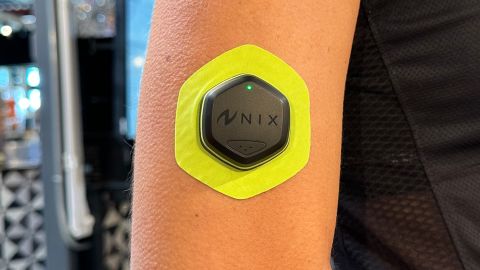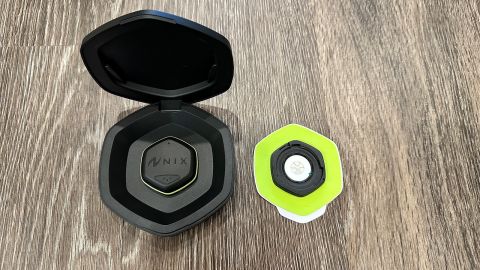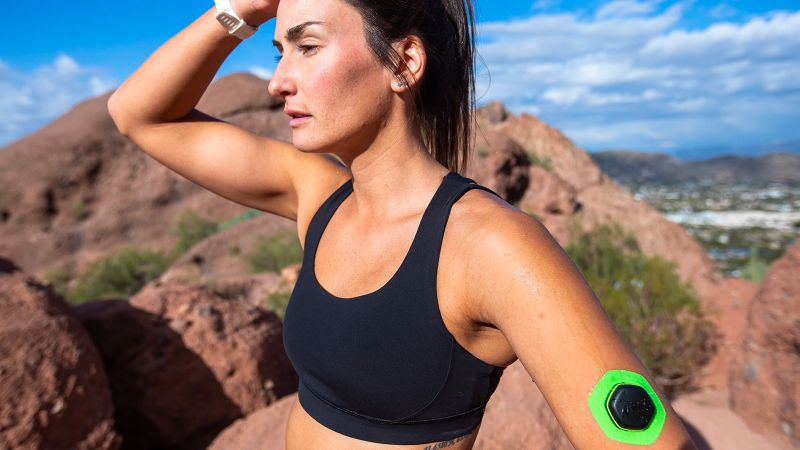Believe it or not, one of the hardest elements of endurance exercise is not the physicality, but figuring out when and how much to drink. For the most part, athletes like runners, cyclists and triathletes use simple trial and error to figure out how much water and electrolytes they need to fuel their workouts. Because despite all the available fancy fitness tracking technology, there hasn’t been a better way to dial in your hydration strategy — until now.
Similar to a fitness or sleep tracker, the new Nix Hydration Biosensor analyzes your sweat in real-time, leading the company to dub it as a “portable hydration lab.” It comes with a sensor and four stick-on adhesive patches, and was created to send mid-workout reminders based on how much fluid you’re losing and processes your sweat data post-workout to suggest the right electrolyte mix for future exercise.
If you’re questioning why anyone might need that much information, consider this: Dehydration can decrease your endurance and increase fatigue, according to a study published in Frontiers in Physiology; meanwhile, electrolytes are crucial for muscle contraction and also play a role in preventing muscle fatigue. The longer you exercise (and the more intense the conditions you’re working out in), the more important it is to make sure you’re consuming enough of both.
As someone who regularly runs for two hours or longer and has absolutely bonked during marathons due to bad hydration choices, I was psyched for a chance to test out Nix’s new biosensor. Here’s what I learned while wearing it during indoor and outdoor runs.
Using an adhesive sensor combined with an easy-to-read mobile app, the Nix Hydration Biosensor not only analyzes your sweat while you exercise, it also suggests a personal hydration strategy to keep you working out longer while preventing muscle fatigue. An ideal product for anyone training for longer races, triathlons or marathons.
Before a workout, you stick one of the patches on your bicep (that’s the best area for sweat testing) and then pop on the sensor. Then, when you go to start a workout in the Nix app, you choose your parameters — like running/cycling, indoors/outdoors — and whether you want fluid loss and/or electrolyte loss notifications. I opted to be notified every time I lost an ounce of fluid (but you can also opt for time-based notifications). During a 35-minute treadmill run, I kept the app open on my phone to see what would happen.
I started visibly sweating around eight minutes in and wiping sweat from my face at 17 minutes, but the app didn’t register any sweat loss until 21 minutes (the app does warn that it could take up to 25 minutes to display data). After that, I could see my losses in real time; at around 25 minutes, I went from 0.6 ounces of fluid loss and 27.5 milligrams of electrolyte loss to 1.3 ounces and 55.1 milligrams. You don’t need to keep the app open, though; on a 10-mile outdoor run, I programmed it to send alerts to my Apple Watch.

After you end a workout, the app uses the data it collected to determine your sweat composition, or how many milligrams of electrolytes lost per ounce of fluid lost. During the shorter indoor run, mine was 44 milligrams per ounce. On the longer outdoor run (when the temperature was 37°F and the humidity 57 percent; that data was noted by the sensor), it was 25 milligrams per ounce.
Within each workout recap, the app includes a chart that shows which hydration beverage most closely matches your sweat composition under those conditions: My indoor run corresponded to Liquid IV, while the outdoor run aligned with Nuun. My takeaway: During longer outdoor training runs in similar temperatures, I should aim to drink 13.8 ounces of water per hour with a Nuun tablet in it.
My first experience using the Nix sensor was during an hour-and-twenty-minute outdoor long run; the temperature was 33°F with 41 percent humidity. I was definitely sweating — it’s hard not to when you’re doing cardio for over an hour, even in near-freezing temperatures — however, the sensor didn’t pick up any sweat data. When I reached out to the company, they said this was unusual but they do see it happen from time to time, particularly in the lower temperature ranges. If your skin temperature drops during the run (i.e. your pace changes or you stop), it can also cause issues. I did try again and got results during a different outdoor session, but I was annoyed to have wasted a whole patch.
While the Nix sensor is reusable, the patches are single-use. When you finish the four sweat patches, you can buy refills in packs of four for $25, which makes sense because once sweat has touched the receptors on the patch, they won’t be able to record accurate data in the future. But it also guarantees more purchases down the road, which will obviously add up over time (especially if you’re not getting readings during workouts).

As cool as this tech is, it’s probably not something the average gym-goer needs to invest in. But if you’re someone training for an endurance feat — whether that’s a marathon, a bike race, a triathlon, etc. — and you’re looking to optimize your hydration for better performance, this little patch can take some of the guesswork out of how much water and electrolytes you need during exercise.
It may not be something you’ll put on during every workout, but if you use it strategically (i.e. during long runs while marathon training, or in conditions that mimic what you expect on race day), you’ll go into race day knowing what you need to perform at your best.





More News
The New York Times and The Washington Post Win 3 Pulitzers Each
Pulitzer Prizes: 2024 Winners List
Assaults on German Politicians Raise Election-Year Worries